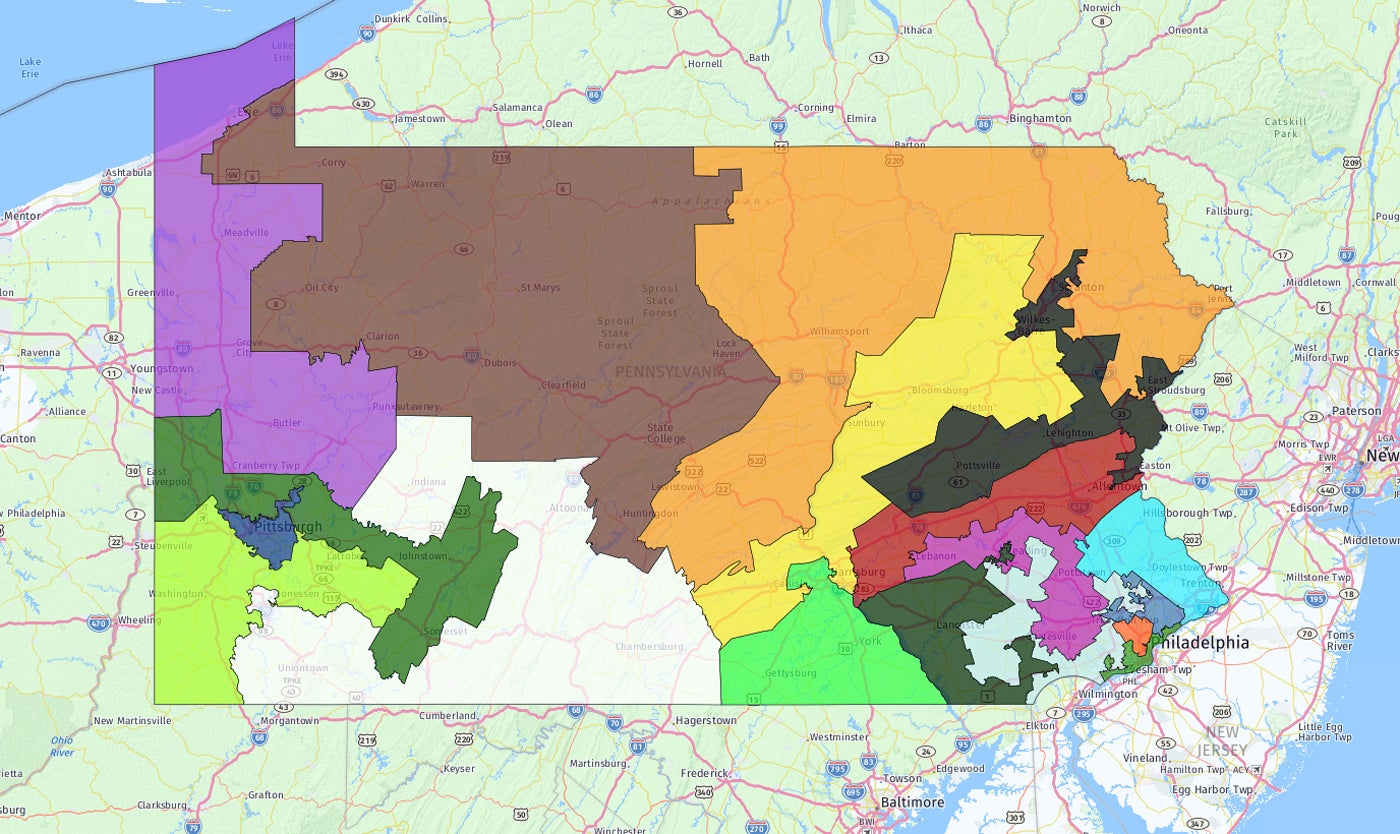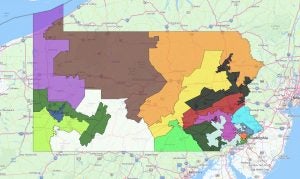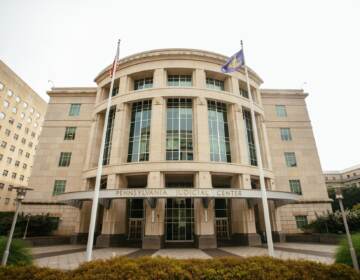Pennsylvania Supreme Court to decide if state congressional district map is a partisan gerrymander

Beth Lawn, a chaplain at a retirement community who lives in Chester, Pa., is one of 18 Democratic petitioners challenging the Pennsylvania congressional district map. (Lindsay Lazarski/WHYY)
Pennsylvania’s congressional district map is often considered one of the most gerrymandered in the United States, but is it unconstitutional? And if so, how do you fix it?
Those are the central questions the Pennsylvania Supreme Court will weigh when hearing oral arguments on Wednesday in a lawsuit that has the potential to change the state’s political landscape.
The case was initiated by 18 voters, all Democrats, and the League of Women Voters of Pennsylvania. Plaintiffs claim Republican lawmakers, who drew the congressional map, violated their state constitutional rights, and are requesting the court to order the state legislature to draw a new map before the primary elections in May.
Each of Pennsylvania’s 18 congressional seats are up for grabs in the 2018-midterm elections.
The Pennsylvania Supreme Court, with a majority of justices elected as Democrats, expedited the case in November. This lifted a stay from a lower court, and ordered a fast-tracked trial in Commonwealth Court to be concluded before the end of 2017.
After hearing a full week of testimony in December, Commonwealth Court Judge Kevin Brobson, elected as a Republican, found that the plaintiffs did not prove the map is unconstitutional.
In his fact-finding report, Brobson said that the plaintiffs showed evidence that partisan considerations went into making a map that favors Republican candidates over Democrats. But he said that political and partisan considerations are permissible when creating congressional districts, and that plaintiffs failed to prove their constitutional rights were violated.
“A lot can and has been said about the 2011 Plan, much of which is unflattering and yet justified,” stated Brobson. “Petitioners, however, have failed to meet their burden in proving that the 2011 Plan, as a piece of legislation, clearly, plainly, and palpably violates the Pennsylvania Constitution.”

At the time of the last redistricting, Republicans controlled the state legislature, governor’s office and Supreme Court. The map became law, though, with significant support from Democrats in the State House, largely from areas where incumbent Democrats saw their seats made safer.
Since the 2011 congressional district map went into affect, Republicans have maintained a 13 to 5 seat advantage in the U.S. House of Representatives through three election cycles.
Statewide, Democrats hold a significant advantage in voter registration, yet the large majority of county governments are controlled by Republicans.
In his recommendations and findings, the judge also said that although the voters claim the evidence of partisanship to be “unfair,” they did not present a manageable standard for the court to determine when permissible political considerations cross a line into unconstitutional partisan considerations.
This week, the state’s highest court — made up of seven justices, five Democrats and two Republicans — will take into account Judge Brobson’s findings and question attorneys representing both sides.
Mimi McKenzie, legal director at the Public Interest Law Center and one of the attorneys representing the voters, is optimistic despite her disappointment in the Commonwealth Court decision.
“Even though the case, legally, didn’t come out as we thought it should, I think, factually, there were some really strong findings in our favor,” said McKenzie. “Most significantly is that the judge in the Commonwealth Court found that this map was drawn with intentional discrimination.”
McKenzie says there’s no exact line in the sand that needs to be drawn to determine when a congressional district becomes an illegal partisan gerrymander. By looking at the whole body of evidence presented, she says the court will be able to recognize that the map goes too far and violates the state constitution.
“Lawmakers should not be using partisan criteria like past elections results, period,” says McKenzie. “When the system is rigged against one group of voters vis-a-vie the other that flies in the face of a representative form of government.”
If plaintiffs are successful, they’re asking the court to order lawmakers and the governor’s office to draw a new map within two weeks that uses non-partisan criteria, employing traditional methods of redistricting such as compactness, contiguity, and keeping communities of interest together.
If that two-week deadline isn’t met, plaintiffs want the court itself to spearhead the creation of a new map.
Battle over districts
Before the trial began, Drew Crompton, chief of staff for Senate President Pro Tempore Joe Scarnati (R-Jefferson County), boiled down the case to it’s essential question: are the districts constitutional?
Crompton and attorneys representing GOP leaders have maintained the answer is “yes.” They are calling on the plaintiffs to drop their challenge, citing the $1 million in legal fees they say taxpayers have incurred thus far to pay for the state’s defense.
“When they were drawn, they were drawn in accordance with a long legacy of cases decided by the U.S. Supreme Court,” said Crompton.
In the case, the map — as a piece of legislation is presumed constitutional. The burden of proof is on the attorneys representing the voters to show otherwise.
“We agree with Judge Brobson’s conclusion,” said Steve Miskin, spokesman for House Speaker Mike Turzai (R-Allegheny). “The constitution, the Voting Rights Act was followed when these maps were put together.
He questions weather any quantifiable harm has been done to the voters in the case.
“We believe they have been represented by members of congress,” says Miskin. “They acknowledge that they have been able to vote. They have been able to donate campaign contributions.”
Christopher Borick, a political science professor at Muhlenberg College, says there’s no doubt partisan politics went into making the map, but he’s doubtful the high court will find the legal logic to rule against it.
“I think there is a strong, strong case to make that this system is not the best system that could be employed for the people of Pennsylvania. It’s a harder case to make that it is an unconstitutional system,” said Borick.
He said the high-profile case could have major implications for Pennsylvania politics.
“This is a big decision for the courts to make in the fact that they are throwing out a system or changing a system that has been in place for a very long time,” said Borick, “While that system is not very popular — to have that done through the judicial process rather than through a legislative process — is a bit risky.”
The case before the Pennsylvania Supreme Court is just one of many other partisan gerrymandering cases being considered by the judicial branch in the state and beyond.
A three-panel panel judge in federal court upheld Pennsylvania’s congressional district map in 2-1 split decision last week. The judges ruled that the challengers’ claim is a political question inappropriate for the courts.
In another case last week, federal judges ruled North Carolina’s congressional district map an unconstitutional gerrymander orchestrated by Republicans.
And the U.S. Supreme Court heard arguments last fall in a challenge from Wisconsin, Gill v. Whitford, and have agreed to hear another battle over partisan gerrymandering alleged to have been perpetrated by Democrats in Maryland.
Borick sees the current wave of court challenges as a backlash against the last round of redistricting, which found partisans embracing rapid advances in computer mapping technology.
“There’s reasonable questions right now, that given some of those technological advances combined with the ways we allow districts to be drawn in many states, that we are simply allowing competition to be pushed out of many districts that would otherwise have more competition,” says Borick.
The Pennsylvania Supreme Court is expected to rule on the case by mid-February.
WHYY is your source for fact-based, in-depth journalism and information. As a nonprofit organization, we rely on financial support from readers like you. Please give today.






